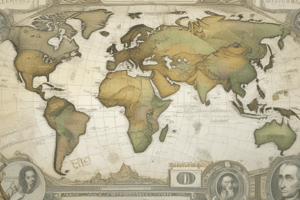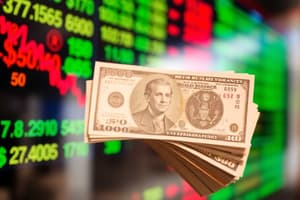Podcast
Questions and Answers
What primarily influences the determination of exchange rates in most cases?
What primarily influences the determination of exchange rates in most cases?
- Currency pegging
- Market monopolization
- Government regulations
- Supply and demand (correct)
What occurs when a country's central bank buys its own currency?
What occurs when a country's central bank buys its own currency?
- It enhances the demand for foreign currency.
- It leads to immediate devaluation.
- It increases the currency supply.
- It eliminates the excess supply. (correct)
What does a downward-sloping demand curve indicate regarding the exchange rate and quantity of pounds demanded?
What does a downward-sloping demand curve indicate regarding the exchange rate and quantity of pounds demanded?
- Exchange rates have no impact on quantity demanded.
- Lower exchange rates increase the quantity demanded. (correct)
- Higher exchange rates increase the quantity demanded.
- Lower exchange rates decrease the quantity demanded.
What happens when the exchange rate is fixed above the equilibrium rate?
What happens when the exchange rate is fixed above the equilibrium rate?
Which of the following is included in the M1 money supply?
Which of the following is included in the M1 money supply?
Which factor would lead to a rightward shift in the demand curve for pounds?
Which factor would lead to a rightward shift in the demand curve for pounds?
What does the term 'devaluation' refer to in currency exchange?
What does the term 'devaluation' refer to in currency exchange?
An increase in interests and taste for British goods would result in what movement for the demand curve for pounds?
An increase in interests and taste for British goods would result in what movement for the demand curve for pounds?
How is money viewed in terms of its functions?
How is money viewed in terms of its functions?
How do relative interest rates affect demand for foreign currency?
How do relative interest rates affect demand for foreign currency?
Which of the following creates a demand for pounds from Americans?
Which of the following creates a demand for pounds from Americans?
What is one effect of rising U.S. real GDP on the demand for pounds?
What is one effect of rising U.S. real GDP on the demand for pounds?
If U.S. prices rise by 10% while British prices remain stable, what is the likely outcome for the demand for pounds?
If U.S. prices rise by 10% while British prices remain stable, what is the likely outcome for the demand for pounds?
What happens to the supply curve of pounds when the British anticipate a gain from holding U.S. assets?
What happens to the supply curve of pounds when the British anticipate a gain from holding U.S. assets?
In a floating exchange rate system, what does appreciation of a currency indicate?
In a floating exchange rate system, what does appreciation of a currency indicate?
What primarily determines exchange rates in the very short run?
What primarily determines exchange rates in the very short run?
What is the consequence when traders expect the pound to depreciate against the dollar?
What is the consequence when traders expect the pound to depreciate against the dollar?
What characterizes the very short run in exchange rate fluctuations?
What characterizes the very short run in exchange rate fluctuations?
Which of the following factors does NOT shift the demand and supply curves for foreign currency exchange?
Which of the following factors does NOT shift the demand and supply curves for foreign currency exchange?
What is defined as depreciation of the dollar in a floating-rate system?
What is defined as depreciation of the dollar in a floating-rate system?
How are exchange rates expected to fluctuate over months or years considered?
How are exchange rates expected to fluctuate over months or years considered?
What happens to the currency of a country with a higher inflation rate compared to a country with a lower inflation rate in the long run?
What happens to the currency of a country with a higher inflation rate compared to a country with a lower inflation rate in the long run?
Which scenario would most likely disrupt the purchasing power parity (PPP) theory?
Which scenario would most likely disrupt the purchasing power parity (PPP) theory?
What is the primary goal of a managed float exchange rate system?
What is the primary goal of a managed float exchange rate system?
What occurs when a fixed exchange rate is set above the equilibrium exchange rate?
What occurs when a fixed exchange rate is set above the equilibrium exchange rate?
Which of the following is NOT a reason why PPP might fail to predict long-term exchange rate trends?
Which of the following is NOT a reason why PPP might fail to predict long-term exchange rate trends?
How does a central bank intervene in the foreign exchange market under a fixed exchange rate system?
How does a central bank intervene in the foreign exchange market under a fixed exchange rate system?
In what time frame is a managed float exchange rate system primarily utilized?
In what time frame is a managed float exchange rate system primarily utilized?
What is the effect of declining GDP on a country's currency?
What is the effect of declining GDP on a country's currency?
What is the role of the Federal Reserve when acting as a bank for banks?
What is the role of the Federal Reserve when acting as a bank for banks?
How does the Federal Reserve influence the money supply through open market operations?
How does the Federal Reserve influence the money supply through open market operations?
What effect does the Federal Reserve's purchase of government bonds have on the money supply?
What effect does the Federal Reserve's purchase of government bonds have on the money supply?
What is the formula for calculating the money multiplier?
What is the formula for calculating the money multiplier?
Which statement correctly describes the relationship between open market sales and the money supply?
Which statement correctly describes the relationship between open market sales and the money supply?
What is one assumption made in the context of open market purchases by the Federal Reserve?
What is one assumption made in the context of open market purchases by the Federal Reserve?
What distinguishes Federal Reserve bond sales from treasury bond sales?
What distinguishes Federal Reserve bond sales from treasury bond sales?
When the Federal Reserve acts as a lender of last resort, what is its primary goal?
When the Federal Reserve acts as a lender of last resort, what is its primary goal?
Flashcards are hidden until you start studying
Study Notes
Foreign Exchange Rates
- Exchange rates are determined by supply and demand just like other markets.
- When looking at the dollar/pound market, the demand for pounds is driven by:
- Americans buying goods and services from British firms.
- Americans buying British assets like stocks, bonds, and real estate.
- The demand curve slopes downwards meaning a lower exchange rate leads to higher demand for pounds.
- Shifts in the demand curve are impacted by:
- U.S. real GDP: Growth leads to increased demand for British goods, shifting the demand curve right.
- Relative price levels: If U.S. prices rise faster than British prices, demand for British goods increases, shifting the demand curve right.
- Increased interest in British goods: Demand for British goods increases, shifting the demand curve right.
- Relative interest rates: Higher interest rates in Britain make British assets more attractive, leading to increased demand for pounds, shifting the demand curve right.
- The supply of pounds is affected by:
- British investors buying U.S. assets: This increases the supply of pounds, shifting the supply curve right.
- Expected changes in the exchange rate: If the British expect the pound to depreciate, they'll buy more U.S. assets, increasing the supply of pounds, shifting the supply curve right.
- A floating exchange rate is determined by supply and demand without government intervention.
- Appreciation of a currency occurs when its price increases due to a shift in supply, demand, or both.
- Depreciation of a currency occurs when its price decreases in a floating exchange rate system.
- Very Short-Run: Exchange rate fluctuations occur over weeks and days, driven by traders moving large volumes of funds and expectations about future exchange rates.
- Short-Run: Exchange rate fluctuations happen over months or years, influenced by economic fluctuations. A rising GDP leads to depreciation, and a falling GDP leads to appreciation.
- Long-Run: Exchange rates are determined by relative price levels between two countries.
- Purchasing Power Parity (PPP): The exchange rate between two countries adjusts in the long run to equalize the average price of goods in both countries.
- PPP Theory Implication: The currency of a country with higher inflation will depreciate against the currency of a country with lower inflation.
- Exceptions to PPP:
- Goods difficult to trade (haircuts, non-tradable goods).
- High transportation costs.
- Artificial barriers to trade (taxes, quotas on imports).
- Managed Float: A country's central bank actively manages its exchange rate by buying its own currency to prevent depreciation and selling its own currency to prevent appreciation.
- Fixed Exchange Rate: A government declares a specific value for its exchange rate with another currency and intervenes in the market to maintain it.
- Foreign Currency Crisis: Occurs when people lose confidence in a country's ability to maintain a fixed exchange rate above the equilibrium rate, leading to increased supply, decreased demand, and rapid depletion of reserves.
- Devaluation: When a government lowers the fixed value of its currency.
Money, Banking & The Federal Reserve
- Money Supply: Refers to the total amount of money in circulation.
- M1: Includes cash in the public, checking account deposits, and traveler’s checks.
- M2: Includes M1 plus savings deposits, money market deposits, and other liquid assets.
- Functions of the Federal Reserve (Fed):
- Bank for banks: Holds reserves, pays interest on these funds, and lends to banks at the discount rate.
- Issues paper currency: Prints money and puts it into circulation.
- Clears checks: Transfers funds between banks.
- Guides the macroeconomy: Uses macroeconomic tools to influence economic activity.
- Deals with financial crisis: Acts as a "lender of last resort" to ensure banks have enough reserves.
- Ways the Fed Changes the Money Supply:
- Open Market Operations: The Fed buys or sells government bonds in the bond market.
- Open Market Purchase: Buying bonds increases reserves and the money supply.
- Open Market Sale: Selling bonds reduces reserves and the money supply.
- Open Market Operations: The Fed buys or sells government bonds in the bond market.
- Money Multiplier: The ratio of the change in the money supply to the initial change in reserves. It depends on the required reserve ratio (RRR), calculated as 1/RRR.
- Treasury vs. Fed: The Treasury borrows money by issuing new government bonds, while the Fed does not borrow. Fed open market operations affect the money supply independent of the government budget.
Studying That Suits You
Use AI to generate personalized quizzes and flashcards to suit your learning preferences.




